The Interaction and Its Evolution of the Urban Agricultural Multifunctionality and Carbon Effects in Guangzhou, China
Abstract
:1. Introduction
2. Materials and Methods
2.1. Study Area
2.2. Data Sources
2.3. Methods
2.3.1. Construction of Multifunctional Index System for Urban Agriculture
2.3.2. Estimation Method of Carbon Emissions and Carbon Sequestration
2.3.3. Granger Causality Test
2.3.4. Grey Association Model
3. Results
3.1. Multifunctional Transformation Process of Urban Agriculture in Guangzhou
3.2. Carbon Effects in the Process of Multifunctional Transformation of Urban Agriculture
3.3. The Causal Test of Multifunctional Transformation and Carbon Effects of Urban Agriculture
3.4. Temporal Characteristics of the Associative Degree between Multifunctionality and Carbon Effects of Urban Agriculture
4. Discussion
4.1. Carbon Emission Reduction Effect of Urban Agricultural Multifunctional Transformation
4.2. Carbon Sequestration Increase Effect of Urban Agricultural Multifunctional Transformation
4.3. A Long Time Lag between Multifunctional Transformation and Carbon Effects of Urban Agriculture
4.4. Uncertainty
5. Conclusions and Policy Enlightenment
Author Contributions
Funding
Data Availability Statement
Conflicts of Interest
References
- Ribeiro, H.V.; Rybski, D.; Kropp, J.P. Effects of changing population or density on urban carbon dioxide emissions. Nat. Commun. 2019, 10, 3204. [Google Scholar] [CrossRef]
- Coutts, A.; Beringer, J.; Tapper, N. Changing Urban Climate and CO2 Emissions: Implications for the Development of Policies for Sustainable Cities. Urban Policy Res. 2010, 28, 27–47. [Google Scholar] [CrossRef]
- Hirano, Y.; Yoshida, Y. Assessing the effects of CO2 reduction strategies on heat islands in urban areas. Sustain. Cities Soc. 2016, 26, 383–392. [Google Scholar] [CrossRef]
- Cheng, Y.; Awan, U.; Ahmad, S.; Tan, Z. How do technological innovation and fiscal decentralization affect the environment? A story of the fourth industrial revolution and sustainable growth. Technol. Forecast. Soc. Change 2021, 162, 120398. [Google Scholar] [CrossRef]
- Anderson, T.R.; Hawkins, E.; Jones, P.D. CO2, the greenhouse effect and global warming: From the pioneering work of Arrhenius and Callendar to today’s Earth System Models. Endeavour 2016, 40, 178–187. [Google Scholar] [CrossRef] [PubMed]
- Rehman, A.; Ulucak, R.; Murshed, M.; Ma, H.; Işık, C. Carbonization and atmospheric pollution in China: The asymmetric impacts of forests, livestock production, and economic progress on CO2 emissions. J. Environ. Manag. 2021, 294, 113059. [Google Scholar] [CrossRef]
- Shan, Y.; Guan, D.; Liu, J.; Mi, Z.; Liu, Z.; Liu, J.; Schroeder, H.; Cai, B.; Chen, Y.; Shao, S.; et al. Methodology and applications of city level CO2 emission accounts in China. J. Clean. Prod. 2017, 161, 1215–1225. [Google Scholar] [CrossRef]
- Luo, Z.; Wu, Y.; Zhou, L.; Sun, Q.; Yu, X.; Zhu, L.; Zhang, X.; Fang, Q.; Yang, X.; Yang, J.; et al. Trade-off between vegetation CO2 sequestration and fossil fuel-related CO2 emissions: A case study of the Guangdong-Hong Kong-Macao Greater Bay Area of China. Sustain. Cities Soc. 2021, 74, 103195. [Google Scholar] [CrossRef]
- Liu, X.; Yu, Y.; Luan, S. Empirical Study on the Decomposition of Carbon Emission Factors in Agricultural Energy Consumption. IOP Conf. Ser. Earth Environ. Sci. 2019, 252, 42045. [Google Scholar] [CrossRef]
- Sauerbeck, D.R. CO2 emissions and C sequestration by agriculture–perspectives and limitations. Nutr. Cycl. Agroecosyst. 2001, 60, 253–266. [Google Scholar] [CrossRef]
- Dong, H.M.; Li, Y.E.; Tao, X.P.; Peng, X.P.; Li, N.; Zhu, Z.P. China greenhouse gas emissions from agricultural activities and its mitigation strategy. Trans. CSAE 2008, 24, 269–273. (In Chinese) [Google Scholar]
- Walker, A.P.; Kauwe, M.; Bastos, A.; Belmecheri, S.; Zuidema, P.A. Integrating the evidence for a terrestrial carbon sink caused by increasing atmospheric CO2. New Phytol. 2020, 229, 2413–2445. [Google Scholar] [CrossRef] [PubMed]
- She, W.; Wu, Y.; Huang, H.; Chen, Z.; Cui, G.; Zheng, H.; Guan, C.; Chen, F. Integrative analysis of carbon structure and carbon sink function for major crop production in China’s typical agriculture regions. J. Clean. Prod. 2017, 162, 702–708. [Google Scholar] [CrossRef]
- Kwakwa, P.A.; Acheampong, V.; Aboagye, S. Does agricultural development affect environmental quality? The case of carbon dioxide emission in Ghana. Manag. Environ. Qual. Int. J. 2021, 33, 527–548. [Google Scholar] [CrossRef]
- Zhan, H.L.; Liu, Y.; Jiao, J. Study on the development of Urban Agriculture in China. Matter-Fact Attitude 2015, 12, 61–66. (In Chinese) [Google Scholar]
- Yoshida, S.; Yagi, H.; Kiminami, A.; Garrod, G. Farm Diversification and Sustainability of Multifunctional Peri-Urban Agriculture: Entrepreneurial Attributes of Advanced Diversification in Japan. Sustainability 2019, 11, 2887. [Google Scholar] [CrossRef]
- Cumming, G.S.; Buerkert, A.; Hoffmann, E.M.; Schlecht, E.; von Cramon-Taubadel, S.; Tscharntke, T. Implications of agricultural transitions and urbanization for ecosystem services. Nature 2014, 515, 50–57. [Google Scholar] [CrossRef] [PubMed]
- Zasada, I. Multifunctional peri-urban agriculture—A review of societal demands and the provision of goods and services by farming. Land Use Policy 2011, 28, 639–648. [Google Scholar] [CrossRef]
- Marques-Perez, I.; Segura, B.; Maroto, C. Evaluating the functionality of agricultural systems: Social preferences for multifunctional peri-urban agriculture. The “Huerta de Valencia” as case study. Span. J. Agric. Res. 2014, 12, 889–901. [Google Scholar]
- Mather, A.S.; Hill, G.; Nijnik, M. Post-productivism and rural land use: Cul de sac or challenge for theorization? J. Rural Stud. 2006, 22, 441–455. [Google Scholar]
- Clive, P.; Jonathan, B. Agricultural multifunctionality in the WTO—legitimate non-trade concern or disguised protectionism? J. Rural Stud. 2002, 18, 35–47. [Google Scholar]
- Orsini, F.; Pennisi, G.; Michelon, N.; Minelli, A.; Bazzocchi, G.; Sanyé-Mengual, E.; Gianquinto, G. Features and Functions of Multifunctional Urban Agriculture in the Global North: A Review. Front. Sustain. Food Syst. 2020, 4, 562513. [Google Scholar] [CrossRef]
- Spataru, A.; Faggian, R.; Docking, A. Principles of multifunctional agriculture for supporting agriculture in metropolitan peri-urban areas: The case of Greater Melbourne, Australia. J. Rural Stud. 2020, 74, 34–44. [Google Scholar] [CrossRef]
- Brinkley, C. Evaluating the Benefits of Peri-Urban Agriculture. J. Plan. Lit. 2012, 27, 259–269. [Google Scholar] [CrossRef]
- Zhou, Z.; Li, M. Spatial-temporal change in urban agricultural land use efficiency from the perspective of agricultural multi-functionality: A case study of the Xi’an metropolitan zone. J. Geogr. Sci. 2017, 27, 1499–1520. [Google Scholar] [CrossRef] [Green Version]
- Oostindië, H.A.; Renting, H. Multifunctionality of Activities, Plurality of Identities and New Institutional Arrangements; Wageningen University & Research: Wageningen, The Netherlands, January 2005. [Google Scholar]
- Zhang, X.; Brandt, M.; Tong, X.; Ciais, P.; Yue, Y.; Xiao, X.; Zhang, W.; Wang, K.; Fensholt, R. A large but transient carbon sink from urbanization and rural depopulation in China. Nat. Sustain. 2022, 5, 321–328. [Google Scholar] [CrossRef]
- Lin, B.; Xu, B. Factors affecting CO2 emissions in China’s agriculture sector: A quantile regression. Renew. Sustain. Energy Rev. 2018, 94, 15–27. [Google Scholar] [CrossRef]
- Tian, J.; Yang, H.; Xiang, P.; Liu, D.; Li, L. Drivers of agricultural carbon emissions in Hunan Province, China. Environ. Earth Sci. 2016, 75, 121. [Google Scholar] [CrossRef]
- Chen, Y.; Li, M.; Su, K.; Li, X. Spatial-Temporal Characteristics of the Driving Factors of Agricultural Carbon Emissions: Empirical Evidence from Fujian, China. Energies 2019, 12, 3102. [Google Scholar] [CrossRef]
- Puigdueta, I.; Aguilera, E.; Cruz, J.L.; Iglesias, A.; Sanz-Cobena, A. Urban agriculture may change food consumption towards low carbon diets. Glob. Food Secur. 2021, 28, 100507. [Google Scholar] [CrossRef]
- Hu, Y.; Sun, J.; Zheng, J. Comparative analysis of carbon footprint between conventional smallholder operation and innovative largescale farming of urban agriculture in Beijing, China. PeerJ 2021, 9, e11632. [Google Scholar] [CrossRef] [PubMed]
- Hu, Y.; Zheng, J.; Kong, X.; Sun, J.; Li, Y. Carbon footprint and economic efficiency of urban agriculture in Beijing—A comparative case study of conventional and home-delivery agriculture. J. Clean. Prod. 2019, 234, 615–625. [Google Scholar] [CrossRef]
- Li, G.D.; Fang, C.L. Quantitative function identification and analysis of urban ecological-production-living spaces. Acta Geogr. Sin. 2016, 71, 49–65. (In Chinese) [Google Scholar]
- Wang, X.J.; Zhang, Y.K.; Zhang, R. Design Practice of Integrating Urban Agriculture into Urban Internal Space in Foreign Countries and Thinking. Urban Plan. Int. 2019, 34, 142–148. (In Chinese) [Google Scholar] [CrossRef]
- Song, T.; Cai, J.M.; Liu, J.P.; Yang, Z.S. Urban Agriculture Experiences in World Cities and its Enlightenments to China. World Reg. Stud. 2013, 22, 88–96. (In Chinese) [Google Scholar]
- Li, P.; Lu, Y.; Wang, Q.; Wu, Y. Discussion on some problems of the modern urban agriculture in Shanghai. Geogr. Geo-Inf. Sci. 2003, 19, 70–73. (In Chinese) [Google Scholar]
- Qiao, W.; Zhang, J.Y. Thinking on predicament and countermeasure of urban agriculture development in China. Rural Econ. 2017, 61–65. (In Chinese) [Google Scholar]
- Zhang, Y.Q.; Wang, Y.; Tian, Y. Urban Agriculture Drives the Integration of Urban and Rural Development: Lessons from International Community and Enlightenment. J. Agric. For. Econ. Manag. 2019, 18, 760–767. (In Chinese) [Google Scholar]
- Li, K.Q.; Sun, X.L. Study on the Coordination between Urban Agriculture Development and Resource and Environment Carrying Capacity of Nanjing. Resour. Environ. Yangtze Basin 2018, 27, 1242–1250. (In Chinese) [Google Scholar]
- Li, M.T.; Zhou, Z.X. Evaluation of urban agriculture multi-functionality development models based on multi-dimension evaluation. Chin. J. Eco-Agric. 2016, 24, 1275–1284. (In Chinese) [Google Scholar]
- Runhaar, H. Governing the transformation towards ‘nature-inclusive’ agriculture: Insights from the Netherlands. Int. J. Agric. Sustain. 2017, 15, 340–349. [Google Scholar] [CrossRef]
- Feng, H.J.; Zhou, Z.X. Study on the relationship and spatial-temporal characteristics of interactive coupling between urbanization and urban agriculture function. Geogr. Geo-Inf. Sci. 2014, 30, 57–63. (In Chinese) [Google Scholar]
- Huang, X.J.; Li, C.G. A relevancy analysis of the coupling between physical environment and population structure. Hum. Geogr. 2011, 26, 114–119. (In Chinese) [Google Scholar]
- Cheng, Y.Q.; Deng, J.X. The association analysis of urban-rural coupling on the major grain-producing areas of central Jilin Province. Econ. Geogr. 2012, 32, 126–130. (In Chinese) [Google Scholar]
- Liu, D.; Zhu, X.; Wang, Y. China’s agricultural green total factor productivity based on carbon emission: An analysis of evolution trend and influencing factors. J. Clean. Prod. 2021, 278, 123692. [Google Scholar] [CrossRef]
- Powlson, D.S.; Stirling, C.M.; Thierfelder, C.; White, R.P.; Jat, M.L. Does conservation agriculture deliver climate change mitigation through soil carbon sequestration in tropical agro-ecosystems? Agric. Ecosyst. Environ. 2016, 220, 164–174. [Google Scholar] [CrossRef]
- Wang, Z.J.; Zhang, H.Q.; Wu, J.X. Impact of low-carbon economy pattern on China’s agriculture industry and development trends in future agricultural production. Res. Agric. Mod. 2011, 32, 542–546. (In Chinese) [Google Scholar]
- Chenu, C.; Angers, D.A.; Barré, P.; Derrien, D.; Arrouays, D.; Balesdent, J. Increasing organic stocks in agricultural soils: Knowledge gaps and potential innovations. Soil Tillage Res. 2019, 188, 41–52. [Google Scholar] [CrossRef]
- Borychowski, M.; Grzelak, A.; Popławski, Ł. What drives low-carbon agriculture? The experience of farms from the Wielkopolska region in Poland. Environ. Sci. Pollut. Res. 2022, 29, 18641–18652. [Google Scholar] [CrossRef]
- Montanarella, L.; Panagos, P. The relevance of sustainable soil management within the European Green Deal. Land Use Policy 2021, 100, 104950. [Google Scholar] [CrossRef]
- Saboori, B.; Sulaiman, J.; Mohd, S. Economic growth and CO2 emissions in Malaysia: A cointegration analysis of the Environmental Kuznets Curve. Energy Policy 2012, 51, 184–191. [Google Scholar] [CrossRef]
- Gacitua, L.; Gallegos, P.; Henriquez-Auba, R.; Lorca, Á.; Negrete-Pincetic, M.; Olivares, D.; Valenzuela, A.; Wenzel, G. A comprehensive review on expansion planning: Models and tools for energy policy analysis. Renew. Sustain. Energy Rev. 2018, 98, 346–360. [Google Scholar] [CrossRef]
- Zhang, J.; Gu, J.; Ji, M.; Wei, G. Impact of Goal Orientation and Information Elaboration on the Performance of Farmer Cooperatives under Rural Revitalization. Rev. De Cercet. Si Interv. Soc. 2021, 72, 398–418. [Google Scholar] [CrossRef]
- Delgado, M.; Porter, M.E.; Stern, S. Clusters, convergence, and economic performance. Res. Policy 2014, 43, 1785–1799. [Google Scholar] [CrossRef]
- Messner, D. A social contract for low carbon and sustainable development: Reflections on non-linear dynamics of social realignments and technological innovations in transformation processes. Technol. Forecast. Soc. Change 2015, 98, 260–270. [Google Scholar] [CrossRef]
- Gosnell, H.; Gill, N.; Voyer, M. Transformational adaptation on the farm: Processes of change and persistence in transitions to ‘climate-smart’ regenerative agriculture. Glob. Environ. Change 2019, 59, 101965. [Google Scholar] [CrossRef]
- Wang, S. Preliminary thinking on the construction of “low-carbon new countryside”. Rural Econ. 2010, 14–16. (In Chinese) [Google Scholar]
- Cotula, L. The international political economy of the global land rush: A critical appraisal of trends, scale, geography and drivers. J. Peasant Stud. 2012, 39, 649–680. [Google Scholar] [CrossRef]
- Manogaran, G.; Hsu, C.; Rawal, B.S.; Muthu, B.; Mavromoustakis, C.X.; Mastorakis, G. ISOF: Information Scheduling and Optimization Framework for Improving the Performance of Agriculture Systems Aided by Industry 4.0. IEEE Internet Things J. 2021, 8, 3120–3129. [Google Scholar] [CrossRef]
- Tang, Y.; Dananjayan, S.; Hou, C.; Guo, Q.; Luo, S.; He, Y. A survey on the 5G network and its impact on agriculture: Challenges and opportunities. Comput. Electron. Agric. 2021, 180, 105895. [Google Scholar] [CrossRef]
- Klerkx, L.; Jakku, E.; Labarthe, P. A review of social science on digital agriculture, smart farming and agriculture 4.0: New contributions and a future research agenda. NJAS Wagening. J. Life Sci. 2019, 90–91, 1–16. [Google Scholar] [CrossRef]
- Liu, Y.; Ma, X.; Shu, L.; Hancke, G.P.; Abu-Mahfouz, A.M. From Industry 4.0 to Agriculture 4.0: Current Status, Enabling Technologies, and Research Challenges. IEEE Trans. Ind. Inform. 2021, 17, 4322–4334. [Google Scholar] [CrossRef]
- Wang, S.; Zhang, G. Achieving Path and Evaluation of Law Carbon Agricultural Production Mode in China. Ecol. Econ. 2012, 28–32. (In Chinese) [Google Scholar]
- Cotrufo, M.F.; Soong, J.L.; Horton, A.J.; Campbell, E.E.; Haddix, M.L.; Wall, D.H.; Parton, W.J. Formation of soil organic matter via biochemical and physical pathways of litter mass loss. Nat. Geosci. 2015, 8, 776–779. [Google Scholar] [CrossRef]
- Zhong, C.; Liu, Y.; Xu, X.; Yang, B.; Aamer, M.; Zhang, P.; Huang, G. Paddy-upland rotation with Chinese milk vetch incorporation reduced the global warming potential and greenhouse gas emissions intensity of double rice cropping system. Environ. Pollut. 2021, 276, 116696. [Google Scholar] [CrossRef]
- Finch-Savage, W.E.; Bassel, G.W. Seed vigour and crop establishment: Extending performance beyond adaptation. J. Exp. Bot. 2016, 67, 567–591. [Google Scholar] [CrossRef]
- Jawad, H.; Nordin, R.; Gharghan, S.; Jawad, A.; Ismail, M. Energy-Efficient Wireless Sensor Networks for Precision Agriculture: A Review. Sensors 2017, 17, 1781. [Google Scholar] [CrossRef]
- Zhou, Y.; Li, Y.; Xu, C. Land consolidation and rural revitalization in China: Mechanisms and paths. Land Use Policy 2020, 91, 104379. [Google Scholar] [CrossRef]
- Liang, L.; Ridoutt, B.G.; Wu, W.; Lal, R.; Wang, L.; Wang, Y.; Li, C.; Zhao, G. A multi-indicator assessment of peri-urban agricultural production in Beijing, China. Ecol. Indic. 2019, 97, 350–362. [Google Scholar] [CrossRef]

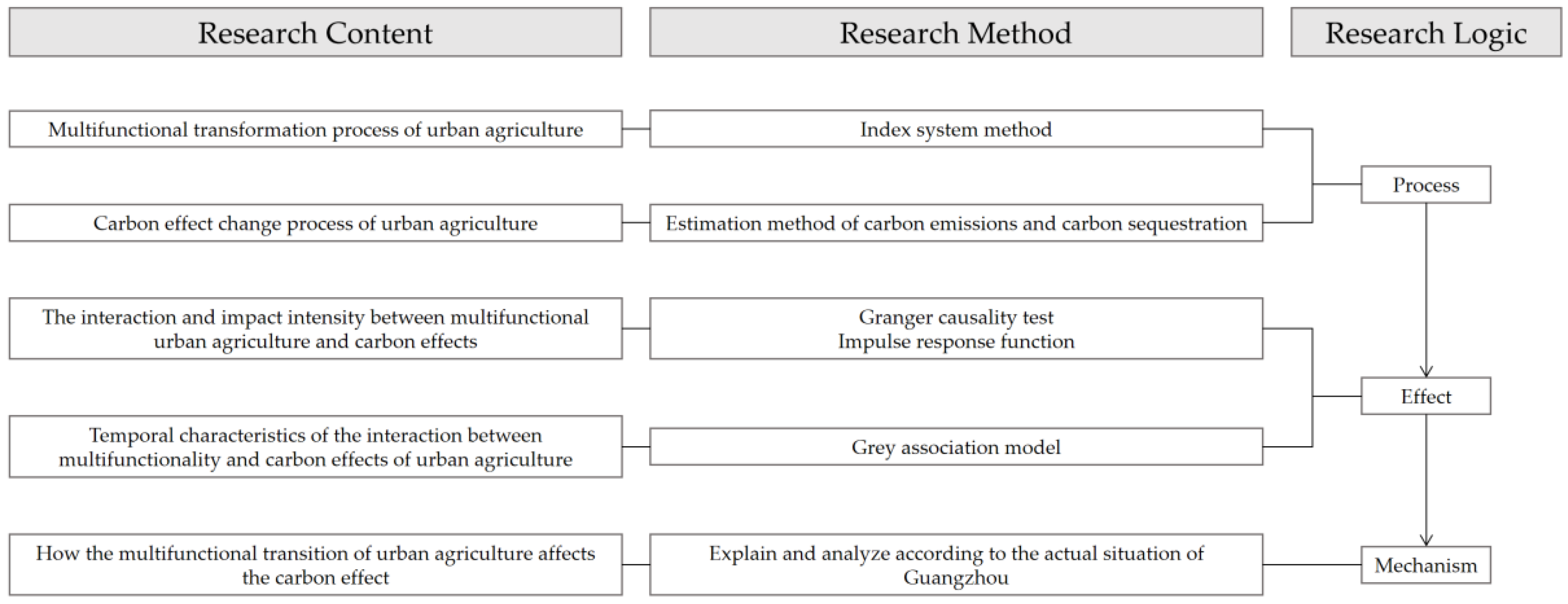


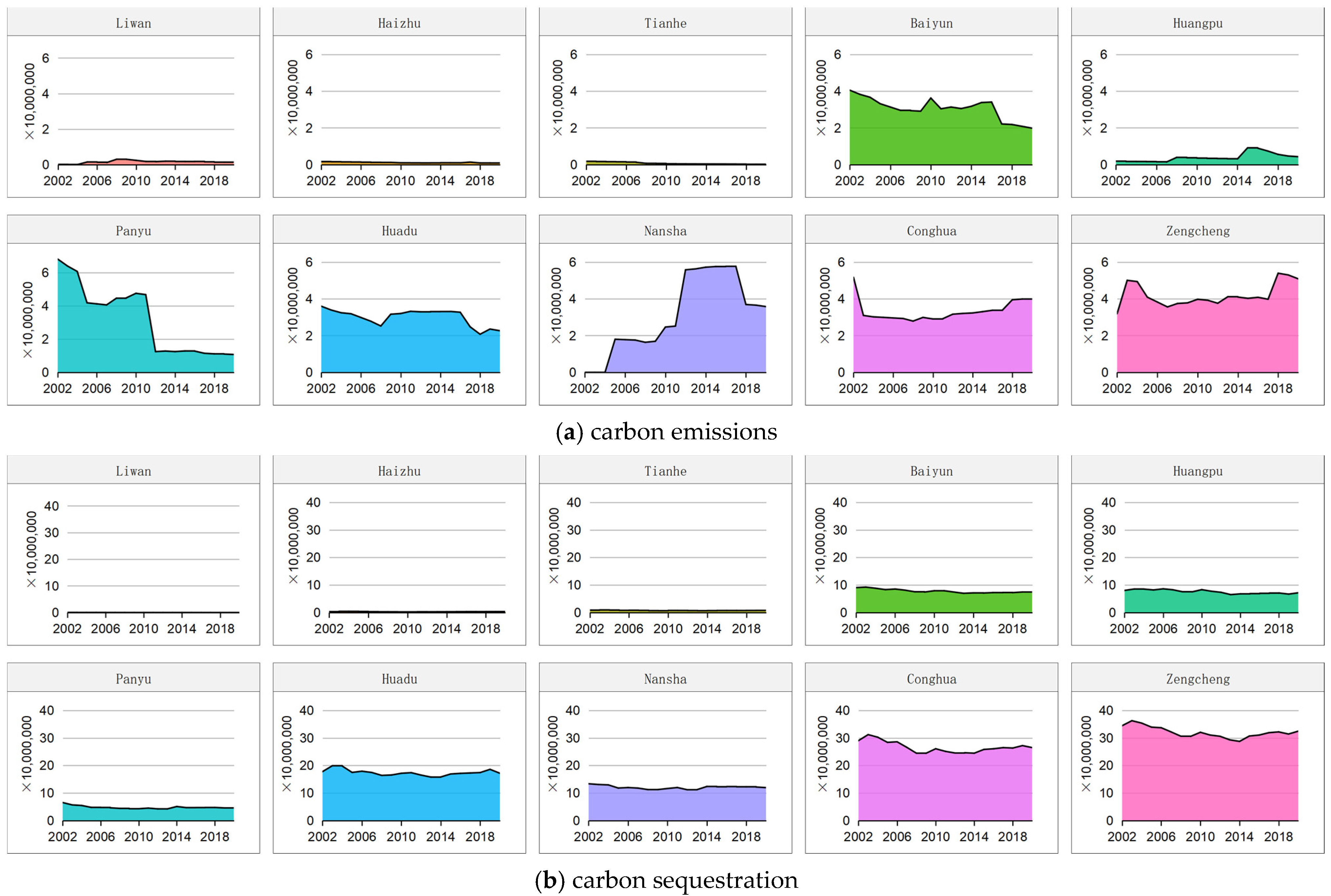
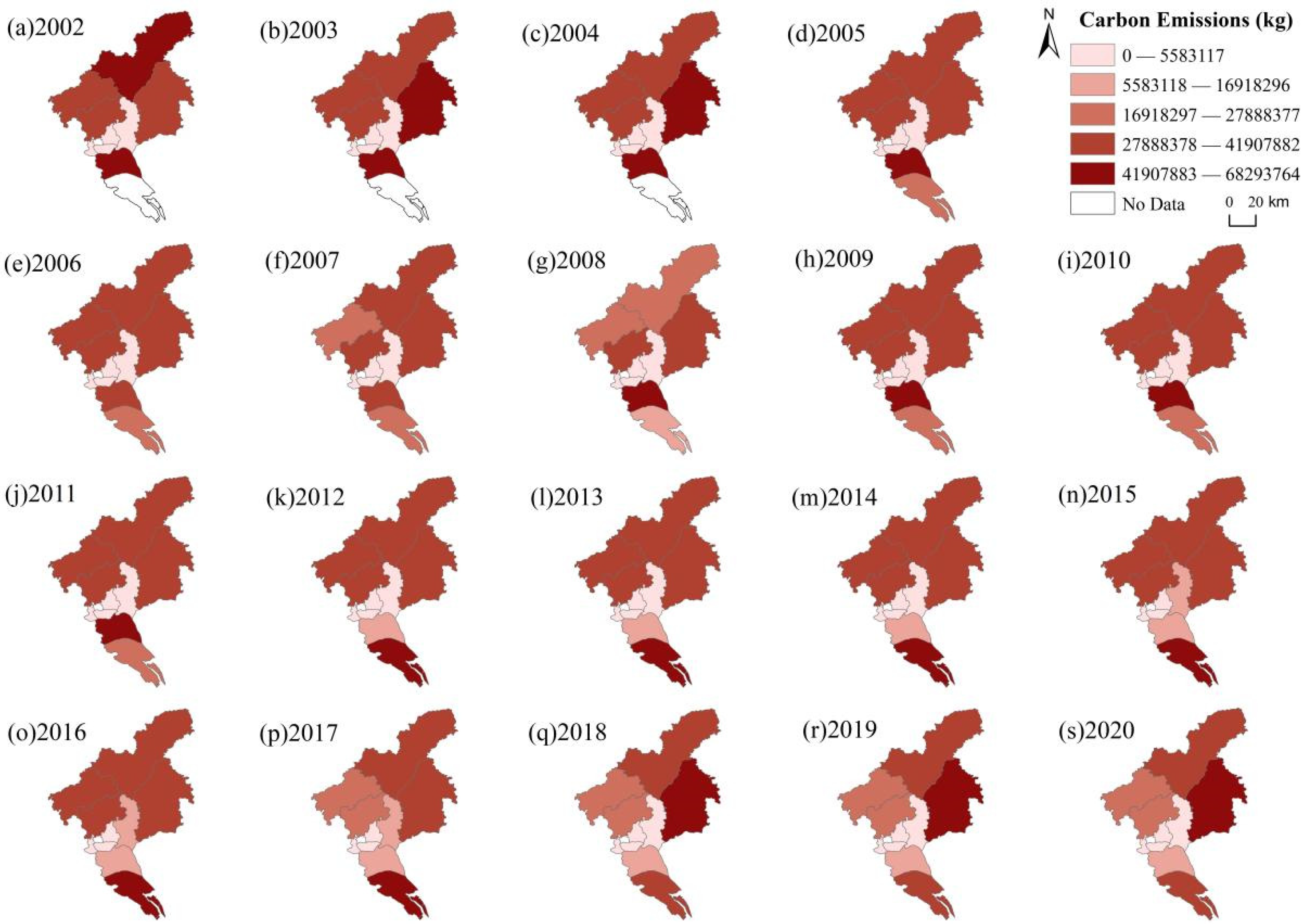

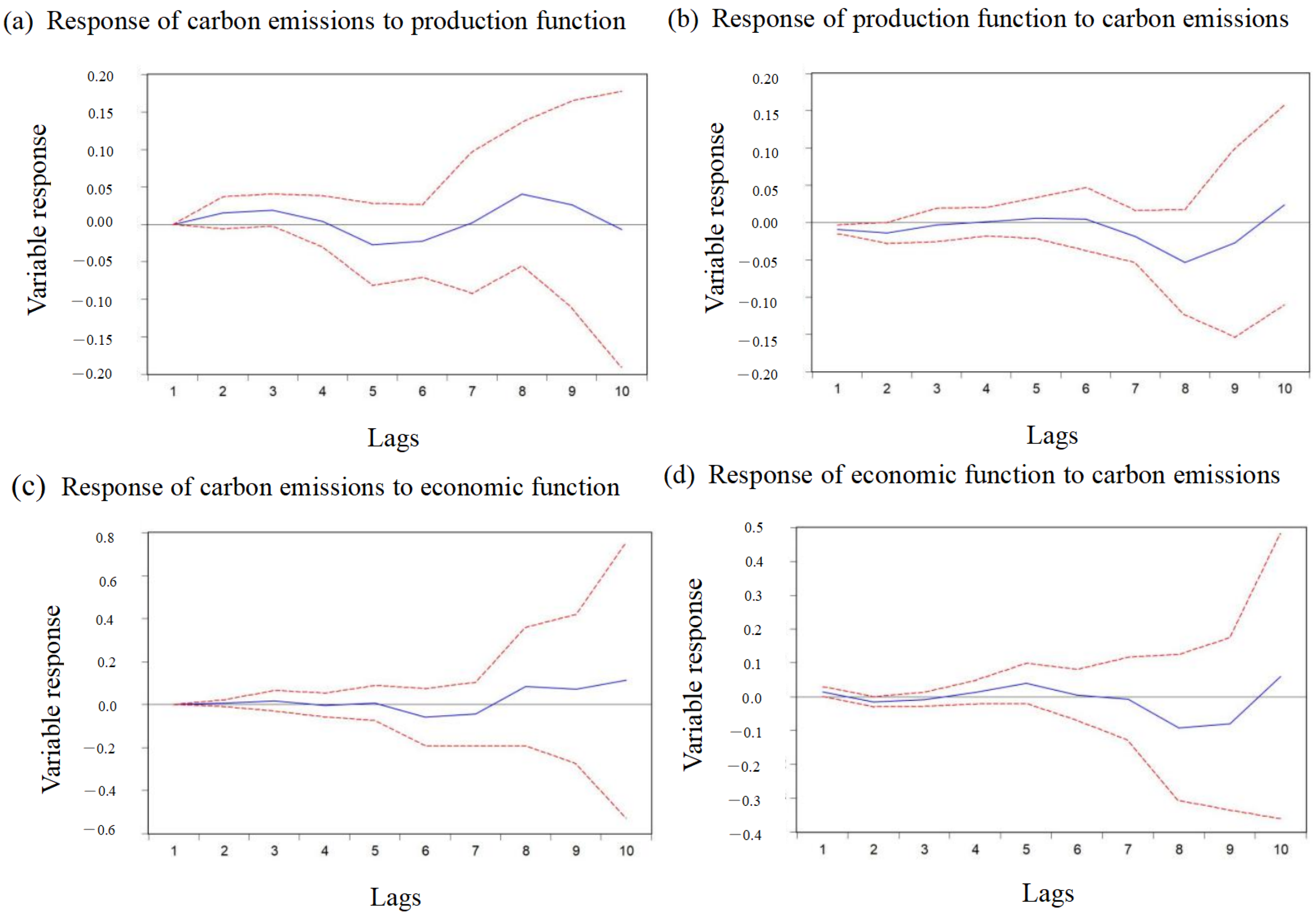

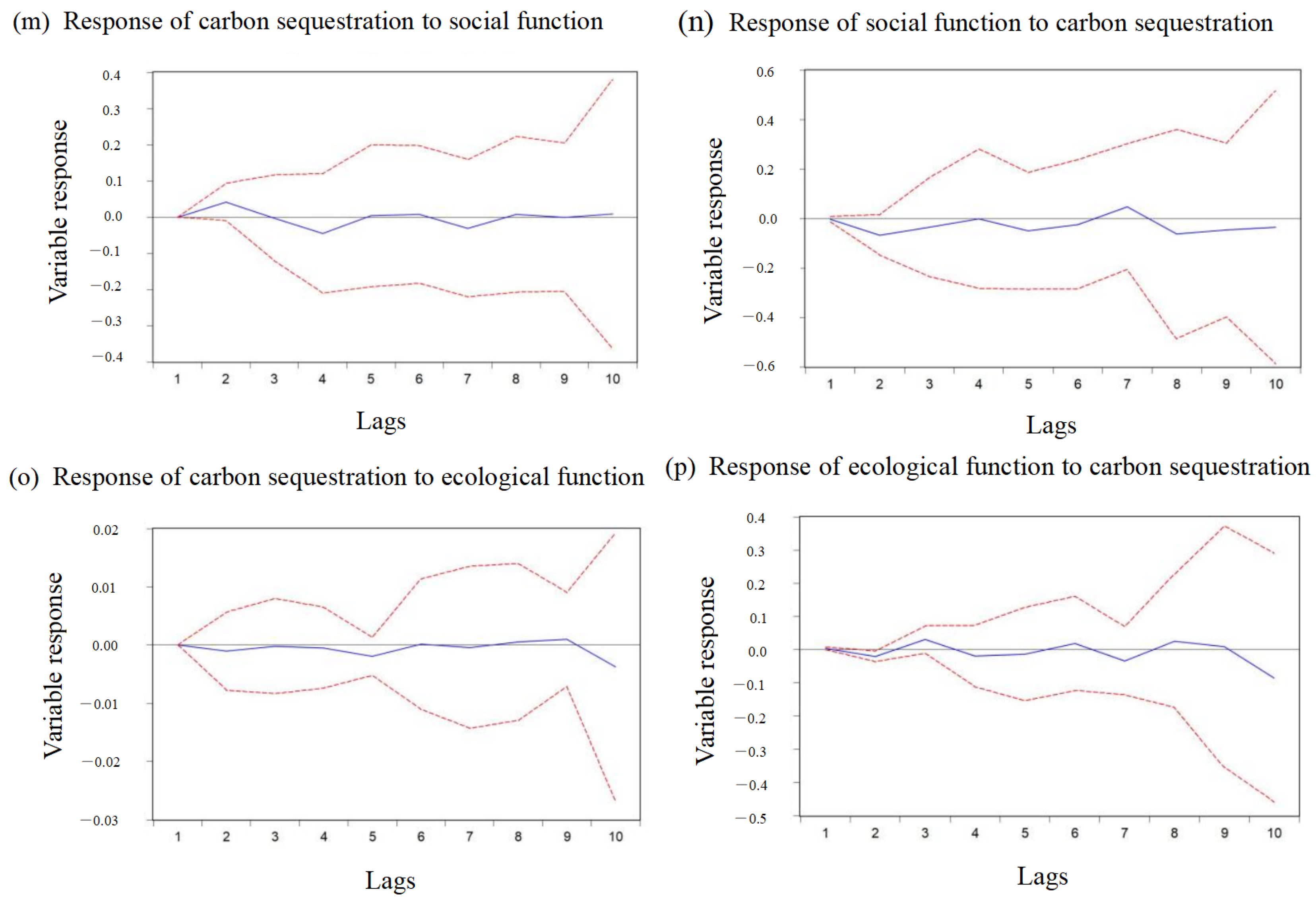

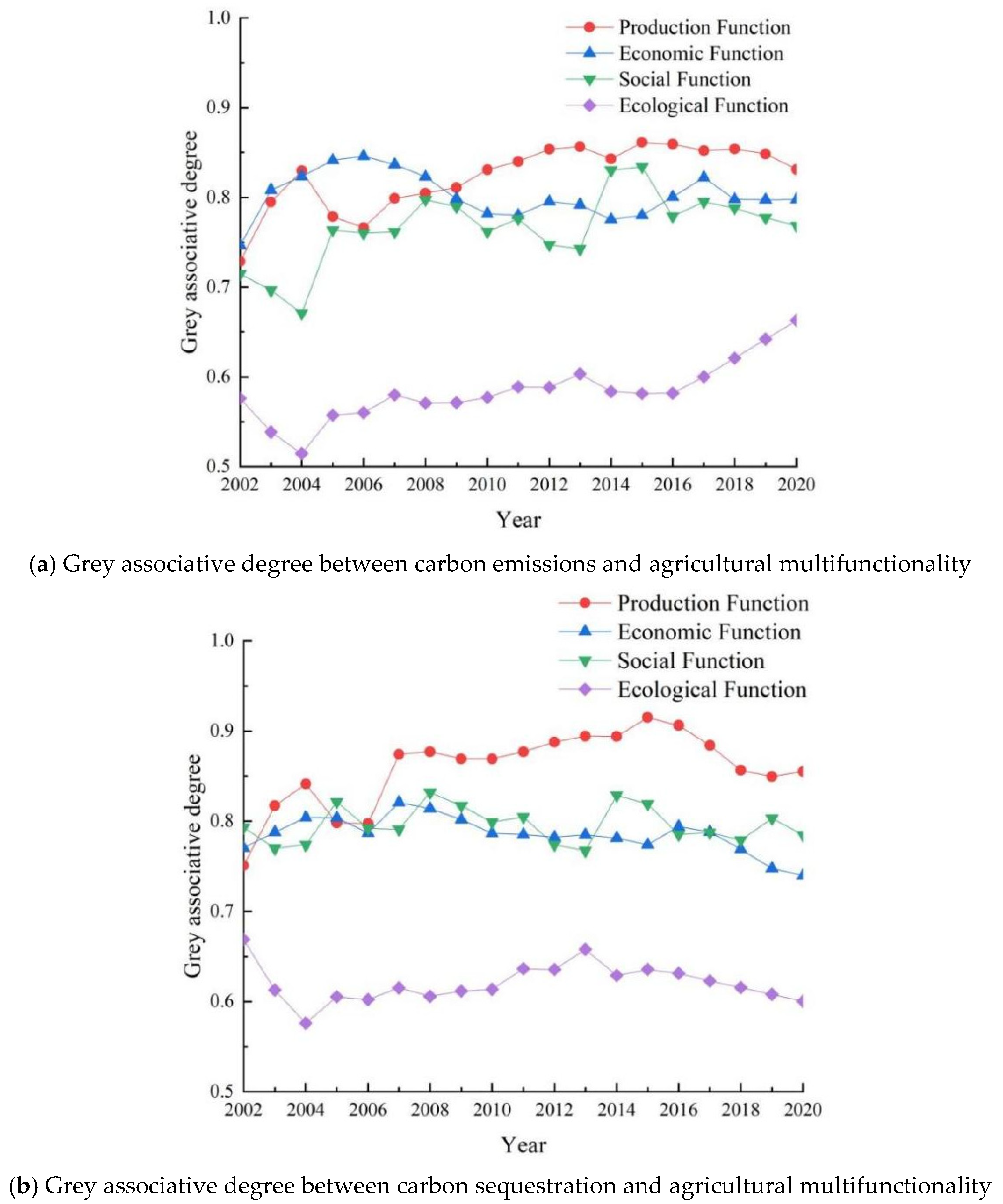
| Function | Index | Calculation Formula | Impact | Weight |
|---|---|---|---|---|
| Production Function | Cultivation index | Area of cultivated land/Land area | + | 8.61% |
| Grain crop output per unit area | Yield of grain crops/Sown area of grain crops | + | 5.33% | |
| Per capita share of grain crops | Yield of grain crops/Permanent population at year-end | + | 40.94% | |
| Per capita share of fruits and vegetables | (Gross output of fruits + Yield of vegetables)/Permanent population at year-end | + | 26.18% | |
| Per capita share of agricultural products in animal husbandry | (Output of milk + Output of poultry eggs + Output of meat)/Permanent population at year-end | + | 18.94% | |
| Economic Function | Agricultural output value per capita | Gross output value of agriculture, forestry, animal husbandry and fishery/Permanent population at year-end | + | 21.11% |
| Proportion of gross output value of agriculture, forestry, animal husbandry and fishery | Gross output value of agriculture, forestry, animal husbandry and fishery/Gross domestic product | + | 25.54% | |
| Cultivated land productivity | Gross output value of agriculture, forestry, animal husbandry and fishery/Area of cultivated land | + | 25.92% | |
| Agricultural labour productivity | Gross output value of agriculture, forestry, animal husbandry and fishery/Total number of employed persons at year-end | + | 26.64% | |
| Rate of commodity output value of agriculture, forestry, animal husbandry and fishery | Commodity output value of agriculture, forestry, animal husbandry and fishery/Gross output value of agriculture, forestry, animal husbandry and fishery | + | 0.79% | |
| Social Function | Per capita income level of rural residents | Per capita annual disposable income of rural residents | + | 29.45% |
| Employment structure level | Number of rural employed persons in agriculture, forestry, animal husbandry and fishery/Total number of employed persons at year-end | + | 38.05% | |
| Agricultural service level | Proportion of service industry for agriculture in gross output value of agriculture, forestry, animal husbandry and fishery | + | 32.5% | |
| Ecological Function | Vegetation coverage | Average of NDVI | + | 49.29% |
| Air quality level | Total annual PM2.5 | - | 23.74% | |
| Degree of farmland fragmentation | Average of PD | - | 26.97% |
| Carbon Source | Carbon Emission Coefficient |
|---|---|
| Agricultural pesticides | 4.9341 kg(C)·kg−1 |
| Plastic film in agriculture | 5.18 kg (C)·kg−1 |
| Chemical fertilizers | 0.8956 kg(C)·kg−1 |
| Agricultural irrigation | 266.48 kg(C)·hm−2 |
| Farmland tillage | 312.6 kg(C)·hm−2 |
| Diesel oil in agriculture | 0.5927 kg(C)·kg−1 |
| Agricultural ploughing | 16.47 kg(C)·hm−2 |
| Agricultural electricity conversion | 0.18 kg(C)·kw−1 |
| Variable | Test Type (C,T,K) | p Value | Result |
|---|---|---|---|
| Carbon emissions | C,0,0 | 0.0000 | Stationary |
| Carbon sequestration | C,0,0 | 0.0000 | Stationary |
| Production function | C,0,0 | 0.0000 | Stationary |
| Economic function | C,0,0 | 0.0000 | Stationary |
| Social function | C,0,0 | 0.0000 | Stationary |
| Ecological function | C,0,0 | 0.0000 | Stationary |
| Variable | Test Type (C,T,K) | p Value | Result |
|---|---|---|---|
| Carbon emissions and Production function | 0,0,0 | 0.0000 | There exists cointegration. |
| Carbon emissions and Economic function | 0,0,0 | 0.0000 | There exists cointegration. |
| Carbon emissions and Social function | 0,0,0 | 0.0000 | There exists cointegration. |
| Carbon emissions and Ecological function | 0,0,0 | 0.0000 | There exists cointegration. |
| Carbon sequestration and Production function | 0,0,0 | 0.0000 | There exists cointegration. |
| Carbon sequestration and Economic function | 0,0,0 | 0.0000 | There exists cointegration. |
| Carbon sequestration and Social function | 0,0,0 | 0.0000 | There exists cointegration. |
| Carbon sequestration and Ecological function | 0,0,0 | 0.0000 | There exists cointegration. |
| Variable | Lag Order | p Value | Result |
|---|---|---|---|
| Carbon emissions → Production function | 8 | 0.0326 | There exists Granger causality. |
| Production function → Carbon emissions | 8 | 0.0058 | There exists Granger causality. |
| Carbon emissions → Economic function | 8 | 0.0011 | There exists Granger causality. |
| Economic function → Carbon emissions | 8 | 0.5414 | There exists no Granger causality. |
| Carbon emissions → Social function | 7 | 0.0000 | There exists Granger causality. |
| Social function → Carbon emissions | 7 | 0.0000 | There exists Granger causality. |
| Carbon emissions → Ecological Function | 8 | 0.0081 | There exists Granger causality. |
| Ecological Function → Carbon emissions | 8 | 0.0479 | There exists Granger causality. |
| Carbon sequestration → Production function | 6 | 0.0000 | There exists Granger causality. |
| Production function → Carbon sequestration | 6 | 0.0000 | There exists Granger causality. |
| Carbon sequestration → Economic function | 6 | 0.0005 | There exists Granger causality. |
| Economic function → Carbon sequestration | 6 | 0.0038 | There exists Granger causality. |
| Carbon sequestration → Social function | 8 | 0.0936 | There exists no Granger causality. |
| Social function → Carbon sequestration | 8 | 0.5513 | There exists no Granger causality. |
| Carbon sequestration → Ecological Function | 8 | 0.0005 | There exists Granger causality. |
| Ecological Function → Carbon sequestration | 8 | 0.7917 | There exists no Granger causality. |
Publisher’s Note: MDPI stays neutral with regard to jurisdictional claims in published maps and institutional affiliations. |
© 2022 by the authors. Licensee MDPI, Basel, Switzerland. This article is an open access article distributed under the terms and conditions of the Creative Commons Attribution (CC BY) license (https://creativecommons.org/licenses/by/4.0/).
Share and Cite
Song, Z.; Yang, R. The Interaction and Its Evolution of the Urban Agricultural Multifunctionality and Carbon Effects in Guangzhou, China. Land 2022, 11, 1413. https://doi.org/10.3390/land11091413
Song Z, Yang R. The Interaction and Its Evolution of the Urban Agricultural Multifunctionality and Carbon Effects in Guangzhou, China. Land. 2022; 11(9):1413. https://doi.org/10.3390/land11091413
Chicago/Turabian StyleSong, Zuxuan, and Ren Yang. 2022. "The Interaction and Its Evolution of the Urban Agricultural Multifunctionality and Carbon Effects in Guangzhou, China" Land 11, no. 9: 1413. https://doi.org/10.3390/land11091413
APA StyleSong, Z., & Yang, R. (2022). The Interaction and Its Evolution of the Urban Agricultural Multifunctionality and Carbon Effects in Guangzhou, China. Land, 11(9), 1413. https://doi.org/10.3390/land11091413



_Sun.png)





